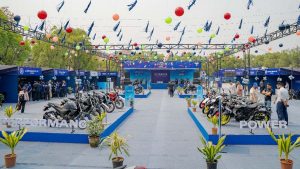
Some families in Pokhara cooking in biogas for three decades

A majority of the houses in Pokhara Metropolitan City cook their meals in LPG and electricity, as these solutions are easily available in the market.
It costs a medium-sized family between Rs 2,000 to Rs 3,000 (USD 15 to USD 22.50) per month for the energy consumed for cooking meals. Interestingly, however, few households in Pokhara have cooking in biogas for the last three decades, thereby saving the expenses spent on cooking energy. Saraswati Bhandari’s family at Mahatgauda in Pokhara Metropolitan City is one among such households.
She has been using the 8 cubic metres biogas plant, which was already installed in her house when she bought the house in 2008. The plant was installed by Pushparaj Sharma, the previous owner of the house in 1993, meaning Pushparaj had operated the biogas plant for over 14 years. Since the purchase of the house, Saraswati and her family have been using the biogas plant which has been operating well, particularly after general maintenance and painting.
The biogas plant that provides clean cooking energy without having to buy and is simple to use, was one of the plus points for her family to consider buying that house. Saraswati had not forgotten the bygone days’ hassles and woes of having to go to the nearby forest to collect firewood and cook meals for hours in smoke-emitting traditional stoves and wash blackened utensils. Thus, she promptly recommended her spouse, Lokraj Bhandari to buy the house without much thought.
According to her, they have been using the biogas for an hour in the morning and an hour in the evening for cooking meals, plus to make snacks in mid-day. It is not that there is no LPG cylinder in her house. “I try to consume biogas, as much as possible. I use LPG, when biogas is not sufficient” The housewife offered insight about cooking energy consumption in her house. The biogas is almost sufficient to cook for her family of six. She, however, uses firewood to cook the buffalo feed.
Compared with the consumption of LPG in her neighbours’ houses, she boasted that one cylinder of LPG would easily last in her kitchen for around four months, while the same would last only for a month in the neighbours’ house. “This way, I save Rs 1,500 in a month by having a biogas plant”, she beamed quipping, “It feels like you are burning money when you use LPG when we get biogas for free!”
Biogas, which is composed of 50-70 per cent methane, 30-45 per cent carbon dioxide and other gases, is produced by the decomposition of organic wastes, by the action of anaerobic bacteria.
In her experience, biogas plant generates a lower quantity of biogas during the winter/cold season. The biogas plant is fed with dung of a buffalo reared in her house and other organic waste coming from a tea and snacks shop in a rented room of her house. Their toilet is also connected to the biogas plant.
The main source of income for her family is farming. She divulged that she yields more harvest from vegetable farming when the digested manure (bio-slurry) released from the biogas plant is applied to the kitchen garden.
After she started using the bio-slurry, a potent and convenient source of organic fertiliser, in the home garden, vegetable production significantly improved, sufficient for her family’s consumption. She was relieved from the economic burden of regularly buying vegetables from the market or purchasing manure for her home vegetable garden.
Her daughter-in-law Asmita Acharya echoed Saraswati’s pride that they have been able to consume organic vegetables from their own home garden. “Since it is easy to work in the kitchen due to biogas, as clean energy, my father-in-law and husband also help in cooking”, Asmita proudly added. “In our house, there is no traditional thinking that women’s place is only in the kitchen. “Anyone having a spare time could work in the kitchen”, Asmita gently boasted.
Similarly, the family of Rudraman Shrestha of BP Marga, Kundar in Pokhara Metropolitan City’s Ward 13 is least worried about the shortage of LPG in the market. The 8 cubic metre biogas plant, which was installed 29 years ago (in 1993), gives him the immense joy of cooking in biogas with convenience for one hour in the morning and one hour in the evening.
Shrestha tried to recall a situation in which the biogas plant at his house had stopped producing biogas for sometime some 10 years ago. But they immediately fixed the problem. After some repair work, the plant has been continuously producing biogas, a renewable source of energy, thereafter.
He also remembers that some families in his neighbourhood had installed biogas plants, but later they switched to LPG and electricity for cooking, demolishing the plant. He narrated that those neighbours lately regret their decision to abandon the biogas plants, when LPG is not available, at times, the price is ever increasing and the electricity supply is also at times, not reliable.
Rudraman, who has a family of five, has recently retired after teaching for almost 30 years. It’s been 15 years since he stopped rearing cattle at his house. Since his source of income squeezed, he has rented four rooms to two families for income. He still gets sufficient biogas for cooking. The biogas plant fed with the kitchen waste of the 3 families in his house and human waste from the toilets used by his family and two other families in rented rooms. His wife Sarala said they use LPG as an alternative only when the production of biogas is not sufficient, during the cold season and when there are guests.
Arjun Gurung confessed that he gets a lot of satisfaction when he sees the plants, he installed 30 years ago, as a mason at Gobar Gas and Krishi Yantra Company Pvt (GGC) are still in operation. According to him, there are many such plants in operation for thirty years in the locality, when the plants are operated with regular repair and maintenance.
In the past, when there was no electricity in villages and there were no solar home systems either, it used to be very difficult for them to meet the increasing demand of consumers to install biogas plants for cooking and lighting energy.
Arjun admits that the usage of biogas for cooking and lighting has decreased significantly, even in rural areas, due to the availability of LPG as the road network improved. He adds that electricity stoves are also in use in rural areas due to grid extension with improving reliability.
He is worried about the decline in cattle rearing and the increase in outward migration in the villages, which result in abandoning many biogas plants, some in a sorry state. He voiced concern saying, “widespread use of imported LPG, in place of biogas produced from organic wastes at home, is not just an economic loss, it has also led to decrease in agricultural activities and animal husbandry and increasing import of food, fertiliser, etc., thereby further deteriorating the country’s economic situation”.
Nepal has over half a century of history in the development of biogas technology. Although the erstwhile government 1973 started the promotion of biogas technology in the country, it was the Dutch development organisation – SNV, which launched the systematic Biogas Support Programme (BSP) in Nepal in 1992, with the Dutch government funding. Subsequently, BSP also received funding from the government of Nepal, the German government, and the World Bank.
SNV implemented BSP from 1992 to 2003, during which altogether 11,000 biogas plants were installed. Prakash Lamichhane, Executive Director of the BSP-Nepal (a national NGO created out of the SNV/BSP team and systems), shared that the nationwide and systematic expansion of the biogas market started in a systematic manner with the launch of BSP in 1992.
SNV support to BSP continued till 2010 when the programme was completely handed over to the Alternative Energy Promotion Centre (AEPC), which is the Nepal government’s nodal agency. During SNV’s support period of 18 years (1992 to 2010) around 231,000 biogas plants were installed. The biogas programme continues with the public-private partnership and with subsidies funded by the government of Nepal and carbon revenue. As of today, about 440,000 household biogas plants have been installed across the country.
Similarly, Saroj Rai, SNV’s Global Technical Advisor for Biodigester Market Development, informed that SNV could still be interested in providing support, in case of need, particularly for the medium and large-size biogas plants. SNV started a small project for medium-sized biogas plants for businesses in 2012, which led to a bigger intervention under AEPC with the World Bank-managed Scaling up Renewable Energy Project.
According to Rai, as of December 2022, over 2 dozen SNV-supported biogas programme countries in Asia, Africa and Latin America have installed over a million household biogas plants.
Navaraj Dhakal, Executive Director of AEPC, said that Nepal’s Nationally Determined Contribution (NDC) submitted to the UN system has emphasised the promotion of household and larger-size biogas plants. He further stated that despite the high degree of electrification in Nepal, it is not possible to provide electric cooking to all households, in the near future. With this, Dhakal argued that there was no option or alternative to going for solutions, such as biogas or even improved cookstoves.
Likewise, Prakash Chandra Subedi, President of the Nepal Biogas Promotion Association (NBPA), said that there was still the possibility of installing around 500,000 household biogas plants in Nepal. He pointed out the need for the State to continue promoting biogas plants and provide subsidies to farmers.
Stating that carbon trading from the biogas programme has already been in Nepal for years, Subedi underscored the need to continue developing and deploying the biogas technology, as a reliable source of clean and renewable energy, also to contribute to climate change mitigation and to Sustainable Development Goals.














Comments